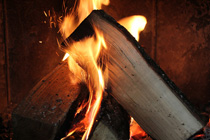Firewood
Choosing wood for fireplace several parameters should be taken into account: its density, hardness, cleavage, content of bark and degree of drying as well as the drying speed. They largely determine the size of the flame, the amount of recovered heat and the amount of smoke that accompanies combustion.
The more dry firewood the harder it is and gives more heat, because it is more calorific. Dry wood burns less flame than wet, but it takes longer. Therefore, although it is expensive, it is generally more economical. The wood must not have too much bark, because it lowers the calorific value.
Calorific value of firewood, that is its efficiency, depends on its density after drying. Burning hard wood is accompanied by a small flame, but it gives more heat. It burns slowly and therefore requires less adding. As a result, although more expensive, it may be more economical and certainly its stock will take up less space than in the case of softwood.
By purchasing wood with high content of bark sometimes we have to order up to three times larger quantity than in the case of the wood that contains less bark. The calorific value of wet wood is low, a large quantity of thermal energy is consumed for the evaporation of moisture. Insufficiently dried firewood will generate smoke and will be harder to inflame. This causes problems with maintaining proper temperature.
The wood drying ability is important when we buy freshly cut wood. This property determines the seasoning period after which wood will be suitable for burning. The differences are very big – from a few months in the case of birch up to three years for oak. The ability of drying up is determined not only by the water content but also by the specific structure of wood.
To ensure wood drying after cutting it be seasoned that is dried under the roof for an average of two years. It may be suitable for burning sooner if it is dried in special chambers with air convection.
Wood of coniferous trees is not quite suitable for firewood regardless of how long it is seasoned. It contains resin which, while evaporating, is deposited on the glass and inside the chimney forming a hard-to-remove greasy layer. The resin under high temperature can “shoot” what in the case of an open fireplace is particularly problematic. In addition, large amounts of smoke and soot produced during combustion are deposited inside the chimney contaminating it and reducing its patency.
Wood from deciduous trees, which contains little resin, does not cause such problems. It burns evenly and does not produce excessive smoke. It results not only in clean glass, but also clean chimney – which is much more hard to clean.
We offer firewood of deciduous trees which is kiln-dried.



CHARACTERISTICS:
- 18-22% humidity inside
- length of slivers 25-30 cm
- split 8 to 15 cm
- packaging: box-pallet volume of 1,0 stere; 1,8 stere; 2,0 stere
The best and most calorific species of wood are hardwood: hornbeam, ash, beech.
| Species | Density after drying | Properties |
| Hornbeam | 830 kg/m3 | Considered as best firewood, highly calorific, burns slowly, a small flame and gives a lot of heat, content of the bark about 7% (low) |
| Ash | 750 kg/m3 | Very hard, calorific, it can be difficult to chop into smaller parts |
| Beech | 730 kg/m3 | Highly calorific, burns evenly and long time, content of the bark about 7% (low) |
| Oak | 710 kg/m3 | Highly calorific – gives a lot of heat and has a pleasant smell. High content of bark – 22%, high content of acids and tannins |
| Birch-tree | 650 kg/m3 | Burns quickly and easily giving steady flame, it contains little tar substances |
| Alder | 570 kg/m3 | It should be very well dried. Owing to nice smell often used for smoking meat |


